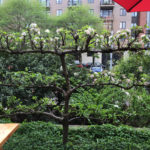Native plants have traditionally been overlooked in formal design. People often equate native plants with being messy or at the very least, wild, yet there are many native plants that are perfectly suitable for formal landscape design. As an example, is this Aronia arbutifolia (red chokeberry) which I’ve espaliered on this client’s fence. The technique of espalier is used to train a tree or shrub flat against a wall or fence. It is generally used for fruit production and the intense pruning required of espaliered fruit trees allows for bountiful production in a very small space. Espalier is also often used to train vines, like ivies, into intricate or geometric shapes, purely for the visual effect.
 The photo to the left shows a young Aronia arbutifloia after it was attached to guide wires. This client needed a small plant species that could easily be maintained at 6-8 feet tall and could tolerate extreme shade and dry conditions under mature oak trees. Both Aronia arbutifolia and A. melanocarpa have supple stems that make the process of espalier even easier, since there will be less pruning required to maintain the desired vase shape in this installation. These native varieties also offer great three-season interest with early white blossoms, glossy green leaves, red berries, and rich red-orange autumn colors.
Suggestions for other native trees and shrubs that could be espaliered include: Aesculus parviflora (bottlebrush buckeye), Amelanchier (serviceberry) species, Cephalnathus occidentalis (buttonbush), Cercis canadensis (redbud), Chionanthus virginicus (fringe tree), Clethra alnifolia (sweet pepperbush), Hamamelis virginiana (witch hazel), Ilex glabra (inkberry), Ilex verticillata (winterberry), Myrica pensylvanica (bayberry), Prunus maritime (beach plum), and Viburnum lentago (nannyberry). Native vines such as Clematis virginiana (woodbine), Parthenocissus quinquefolia (Virginia creeper), and Wisteria frutescens (American wisteria) are also possible candidates for espalier training.
Below are examples of traditional espalier:
The photo to the left shows a young Aronia arbutifloia after it was attached to guide wires. This client needed a small plant species that could easily be maintained at 6-8 feet tall and could tolerate extreme shade and dry conditions under mature oak trees. Both Aronia arbutifolia and A. melanocarpa have supple stems that make the process of espalier even easier, since there will be less pruning required to maintain the desired vase shape in this installation. These native varieties also offer great three-season interest with early white blossoms, glossy green leaves, red berries, and rich red-orange autumn colors.
Suggestions for other native trees and shrubs that could be espaliered include: Aesculus parviflora (bottlebrush buckeye), Amelanchier (serviceberry) species, Cephalnathus occidentalis (buttonbush), Cercis canadensis (redbud), Chionanthus virginicus (fringe tree), Clethra alnifolia (sweet pepperbush), Hamamelis virginiana (witch hazel), Ilex glabra (inkberry), Ilex verticillata (winterberry), Myrica pensylvanica (bayberry), Prunus maritime (beach plum), and Viburnum lentago (nannyberry). Native vines such as Clematis virginiana (woodbine), Parthenocissus quinquefolia (Virginia creeper), and Wisteria frutescens (American wisteria) are also possible candidates for espalier training.
Below are examples of traditional espalier:





Two-year old red chokeberry being trained as espalier.

Espalier Shapes

Espaliered Apple Tree, Portland, OR

UBC Botanincal Garden Vancouver, BC

Chicago Botanic Garden
